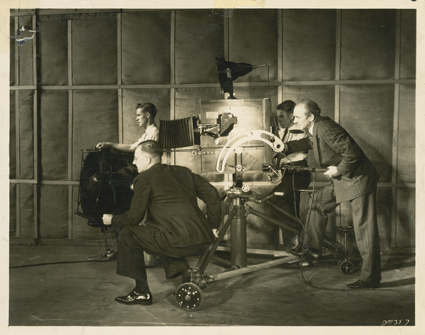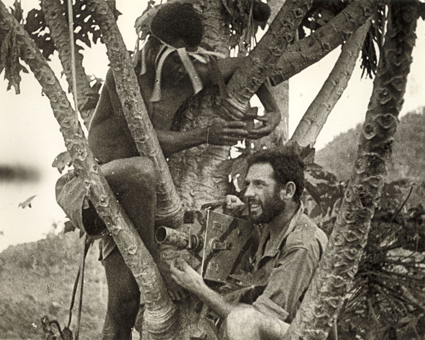an illuminating history: the faces behind the cameras
keith gallasch: martha ansara, the shadowcatchers

The Silence of Dean Maitland (1935), left: Frank Hurley (cinematographer); seated: Ken G Hall (director); photo courtesy of National Film and Sound Archive
TRUE TO ITS SUBJECT, THE SHADOWCATCHERS IS A VISUALLY RICH HISTORY OF AUSTRALIAN CINEMATOGRAPHY. ALMOST 400 PHOTOGRAPHS, OFTEN THE WORK OF STILLS PHOTOGRAPHERS ON LOCATION, CAPTURE GENERATIONS OF CAMERAMEN LABOURING IN STUDIOS, IN THE BUSH, UNDERWATER, PEERING AT INSECTS, SWEATING OVER TINY CLAY FIGURINES, PERCHED IN TREES, HANGING FROM SPEEDING CARS AND INVENTIVELY ENGAGING WITH EVER EVOLVING EQUIPMENT.
The Shadowcatchers, published and produced by the Australian Cinematographers Society (ACS), is much more than a beautifully designed, very big picture book in glorious widescreen format. Not a book to browse on the lounge or in bed, once opened out on a table to reveal its full visual impact, it equally offers engrossing, informative and entertaining reading. Author Martha Ansara, a cinematographer herself (and producer and director), writes elegantly, tracing the history of the craft across key periods of the development of filmmaking and television in Australia, interpolated with detailed accounts of the lives, styles and achievements of ACS Hall of Fame members. As well there are quotations from cameraman (drawing on the ACS’s substantial archive) that are variously insightful, amusing and alarming.
Given that Australian cameramen (including a handful of women) have been integral to Australian film and television history, Ansara deftly delineates the various social and political forces that have inhibited and encouraged development for over a hundred years. You can come to this book without a knowledge of that history and come away well informed, having also been introduced to some of the technical aspects of camera craft. Much of this is fascinating as we read of cameramen in the 1920s and 30s developing film in their kitchens, making an optical printer out of Meccano or inventing lenses while ‘slushy boys’ fight to keep dust out of processing. Most of the technical information is quite intelligible—only occasionally I found myself turning to Wikipedia to check out blimps and fluidheads.
What gives The Shadowcatchers wonderful cogency is, first, its sense of lineage and heritage and, second, the idiosyncratic Australian character of the history that Ansara unfolds. As you turn the pages you’ll see cameramen grow older, you’ll witness their assistants becoming cameramen and innovators in their own right across the generations. The use of the term ‘cameraman’ is critical. As Ansara tells it, the cameraman from the beginnings of Australian film (not ‘film industry’—we were long denied that) was remarkably multi-skilled and there was no such thing as a simple career path. As camera operator, director, editor and processor, the early cameraman deserves retrospective acknowledgment as filmmaker. Although specialists very gradually supplanted these roles, Australians frequently continued to display superb skills as visual journalists (Neil Davis and David Brill in 1970s war zones) and technical innovators as well as moving into directorial and producer roles. ‘Cinematographer’ is self-defining, but it was interesting to read that cinematographer John Seale insists on being his own cameraman. (The section on Seale is a good example of the book’s brisk, evocative delineation of character and craft.)
As well as the sense of lineage, there are other strands that emerge, for example the considerable number of cameramen who found their way into film through photography, sometimes as a childhood hobby, sometimes maintaining that career side by side with filmmaking. More than a few worked their way up from the periphery of the trade and a surprising number, even up to recent times, didn’t complete secondary schooling or suffered learning problems. Cameramen are frequently revealed to be battlers, especially in the early days—denied good film stock and equipment (hence the drive to innovate), working long hours, sometimes in dangerous circumstances, mocked (by fellow cameraman as well as management) for artistic pretensions into the 1950s, and subordinated to foreign cinematographers on imported productions (but signing up as cameramen for the experience, new ideas and, sometimes, quality equipment, if shocked by the overseas caste system of filmmaking).
In the 1960s and 70s cameramen who once might have worked for commercial studios or television found their niche in the exploratory work of the Commonwealth Film Unit or established themselves as freelancers. Geoff Burton, Peter James, Russell Boyd, Don McAlpine and others took with them their own crews from feature film to feature film from the 70s onwards (including to the US). As Ansara writes about technological change, ironically many filmmakers today are like their antecedents—multi-skilled, now working inventively with inexpensive soft and hardware. Top cinematographers work with incredibly expensive technology but are no longer lone masters of their craft—the video spilt while filming allows all the ‘creatives’ to see the shots, eliminating the need for rushes and reducing the cameramen’s sense of having got it right on their own. As well, post-production has become hyper-elaborate, the final look of the film moving further and further away from the shooting and requiring even more sophisticated technical knowledge and collaborative commitment from the cinematographer. Ansara estimates that “50% of current Australian product is news, sport, current affairs and variety/light entertainment.” Cinematographers are “reliant on the same kind of work that was the mainstay of the old Cinesound and Movietone cameraman, albeit in a modern form.”
The photographs are consistently revealing, a perfect match with Ansara’s history and the anecdotes and the Hall of Fame profiles. We see the sheer bulk of both early feature film cameras and the very latest too (with an undaunted Andrew Lesnie standing before them) alongside generations of small newsreel cameras and the most recent digital portables. The filmmakers of the first half of the 20th century, in studios or on the streets, wear suits (as in the photograph of Frank Hurley behind the camera on this page). Another image of Hurley shows him, without suit, washing his film in the Antarctic ocean after shipboard processing for Hour of the Blizzard (1913). The book’s mix of portraits and unposed shots makes for a variety of perspectives on the people behind the camera and the circumstances of their work.
The elegant, suited shots of studios in production mode sometimes belie the demands on filmmakers: the Bondi Junction skating rink, much used as a studio in the 30s, had to be vacated at night for skaters, or the Cat Pavilion at the Sydney Showground emptied of heavy film equipment to make way for competitive cats. Bill Trerise, a leading newsreel maker, looks gentlemanly enough in the pictures, but was known as Bloody Bill for his tyrannical behaviour. He won acclaim for a clever strategy to create a slow motion film finish to a Melbourne Cup. He was criticised by local management but the New York office applauded the innovation.
Bill Carly, a leading cameraman who collaborated with Trerise on Jungle Partrol (1944), was furious when Howard Rubie, a young assistant cameraman, posted a quotation about film as art from the great documentarist Howard Grierson on a staff notice board. Carly tore it down and no one on the staff spoke to Rubie for a week. Hugh McInnes, who apparently “took to Trerise with a spanner” at one time, was dismayed by the intrusion of directors and “film society people” in the 50s. Ansara tells us that filmmakers largely comprised left wing Catholics, further bonded by meeting at particular pubs, mateship in often tough working conditions and an emerging need to unionise. This bond was not very accommodating for a young female clapper loader even in the 1970s as Jan Kenny (later a cinematographer and teacher at AFTRS and the only woman in the ACS Hall of Fame) explains in painful detail—the crew waiting for her to fail or drop heavy equipment until she’d proven herself. Not something that would happen today, she says. (Although many women work in film these days, Ansara points out that only 3% of the 700 ACS membership are women.)

Damien Parer, 1943, with New Guinean assistant Cyril and Newman Sinclair camera
Frame enlargement courtesy John Hosking
Damien Parer, 1943, with New Guinean assistant Cyril and Newman Sinclair camera
The contribution of the newsreel, ethnographic and commercial promotional film to the evolution of Australian cinematography is never underestimated by Ansara. The documentation of World War II by the federal government’s Department of Information Film Division (later the Commonwealth Film Unit) expanded the approach to filming through the work of Damien Parer who had trained with Arthur Higgins, a leading cinematographer in the 30s in features and documentaries. Influenced by European filmmakers, Parer proved that the handheld camera could provide authenticity and convincing journalism. His Kokoda Front Line (1942) won an Academy Award. He was killed in battle in 1944. His heritage has been realised in the work of Neil Davis (who died filming a coup in Thailand) and David Brill, particularly in their coverage of the Vietnam War. It was Brill who declared, “I’m a video journalist.” These were cameraman who, as Ansara, points out, constructed stories as they filmed.
Risk is a substantial theme in the book, covering everything from lugging backbreaking equipment to working in appalling weather and cruel locations. Then there are the accidents—Keith Gow, left with the imprint of a camera on his face for the rest of his life when a plane taking off over him dipped in an air-pocket, nearly killing him. Les Walsey recalls shooting a bush fire in the 50s in a suit: “the flames were leaving the railway line and the ash falling on my nylon pop-on shirt and it was going ‘Pshheew! Pshhew!’—holes all over. I ended up with a shirt like a colander. Here we were covering a bush fire in shirts and ties—this is how we dressed because we were professionals.” Howard Rubie admits, “because you had the camera you felt that nothing could happen to you.”
Another recurrent theme is the famed ability of our cinematographers to deal with extremes, and subtleties, of light. Ross Wood says, “When you go overseas and come back again, you notice how hard our light is…those heavy shadows under. I’d like to utilise that midday sun, I think it’s terribly characteristic of this place…this hat with no face underneath it, I’d like to use it: almost a Ned Kelly feel about it, I suppose, the square head with no detail—just a block.”
The lineage theme so strong among cameramen since filmmaking’s inception here continues into the 70s and beyond with Australian directors and cinematographers forming significant teams here and overseas while cinematographers and their crews continue, writes Ansara, to display the characteristic ability to work fast, across genres, in harsh conditions and with a sense of team.
The book gives substantial space to documentary cinematographers including the great innovator Jim Frazier, whose Panavision-Frazier Lens has allowed for intense, stable close-ups and depth of field that have found their way into his work for David Attenborough, Mark Lewis’ Cane Toads: An Unnatural History (1987) and Jurassic Park.
Many other cinematographers are accounted for in Ansara’s history or in numerous images of them at work. The Shadowcatchers is a monumental and generous representation of those skilled artists who work with and behind the camera, largely unknown to the audiences who enjoy and admire their work. Here they are made visible. Ansara and the ACS have proudly celebrated the achievements and legacy of the profession with superb design by Ana May and production by Eddy Jokovich of ARMEDIA, fine writing and superb documentation.
Read Tina Kaufman’s interview with Martha Ansara and Calvin Gardiner in RealTime 108.
Martha Ansara, The Shadowcatchers, ACS, Austcine Publishing, North Sydney, 2012; 288p, soft cover $66, hardbound limited edition signed by Academy Award-winning Australian cinematographers, $250
RealTime issue #109 June-July 2012 pg. 20






